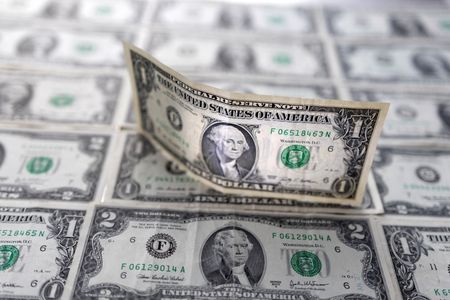By Saqib Iqbal Ahmed
NEW YORK (Reuters) -The dollar edged up to a three-month high against the euro on Monday, extending its gains from last week on doubts about the outlook for another Fed rate cut this year.
The Federal Reserve lowered interest rates by 25 basis points last week, as expected, but Chair Jerome Powell signalled that may be the last cut this year, citing the risk of making additional moves without a more robust picture of the economy.
Were it not for the ongoing U.S. government shutdown, data releases scheduled for this week, including U.S. non-farm payrolls, would have helped with that picture.
With government releases likely to be delayed again, investors will be left with ADP employment data and ISM PMIs, though it seems unlikely these will move the dial significantly.
‘QUITE A BIT OF DOUBT’ ABOUT DECEMBER RATE CUT
“There was quite a bit of doubt cast on the likelihood of a follow-up December rate cut,” said Shaun Osborne, chief currency strategist at Scotiabank.
A number of Fed bank presidents on Friday aired their discomfort with the decision to ease policy, while Federal Reserve Governor Stephen Miran on Monday argued for being more aggressive with rate cuts.
“I don’t recall, in all the years of watching these markets, public division among Fed policymakers as significant as this on the policy outlook,” Osborne said.
Traders are now pricing in a roughly 70% chance of a 25 bp cut in December, down from about 94%, a week ago.
EURO HITS WEAKEST VS DOLLAR SINCE AUGUST
The euro, which slipped as low as $1.1505 against the dollar, its weakest since August 1, pared losses to trade down 0.1% at $1.1518, after data showed U.S. manufacturing contracted for an eighth straight month in October as new orders remained subdued, and suppliers were taking longer to deliver materials to factories against the backdrop of tariffs on imported goods.
The dollar was up 0.37% to 0.8075 Swiss francs, its highest since mid-August.
The yen was about unchanged on the day against the dollar, languishing near an 8-1/2-month low, pressured by wide interest rate differentials.
Still there remained risks to the dollar, including the U.S. government shutdown that has disrupted the supply of government data crucial to gauging the strength of the economy.
“I don’t think it is guaranteed that the dollar continues to strengthen,” Osborne said.
POUND, YEN FACE THEIR OWN PRESSURES
For now, the pound and the yen face their own pressures.
Even though Bank of Japan Governor Kazuo Ueda last week sent the strongest signal yet that a rate hike was possible as soon as December, markets remained underwhelmed by the central bank’s gradual approach, particularly given that the Fed has turned more hawkish.
That has piled pressure on the yen, prompting jawboning from Japanese authorities to stem the currency’s slide.
The yen is approaching levels at which Japanese authorities intervened in markets in 2022 and 2024 to support the currency.
Sterling has softened as market expectations of another Bank of England rate cut this year increased after softer-than-expected inflation data released last month. On Monday, the pound was 0.3% lower at $1.31295.
The BoE meets this week, with some analysts predicting a 25 basis point cut, though market pricing only reflects a one in three chance of this occurring.
The Aussie slipped 0.2% to $0.6533. The currency has found some support from expectations that the Reserve Bank of Australia will hold rates on Tuesday, following an uncomfortably high reading of core inflation.
Cryptocurrency bitcoin <BTC=> was down 2% at $107,486.
(Reporting by Saqib Iqbal Ahmed; Additional reporting by Alun John and Rae Wee; Editing by Kirsten Donovan, Hugh Lawson and Conor Humphries)











